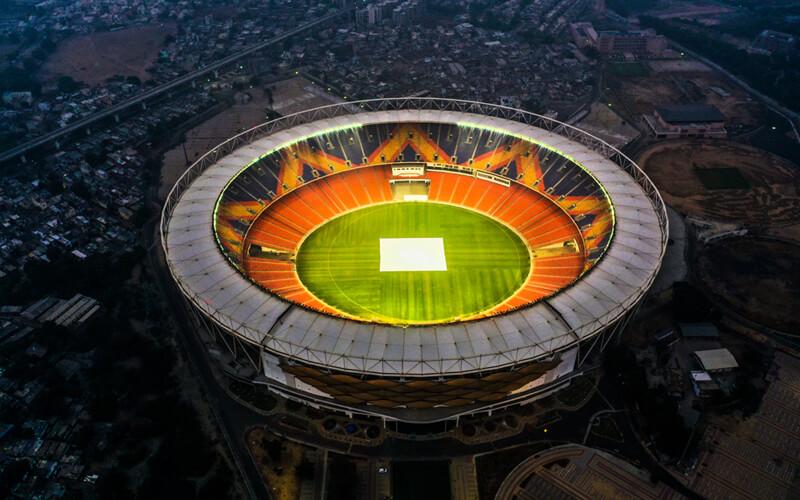Millions of Indian cricket fans must have seen the viral video on social media in which some boorish cricket fans at the Narendra Modi Stadium in Ahmedabad chanted “Jai Shri Ram!” (Hail Lord Ram!) as Pakistani batter Mohammad Rizwan walked back to the pavilion after being dismissed in the match against India on October 14 in the ongoing ICC Cricket World Cup. In recent times, the invocation has been weaponised by right-wing groups to carry out atrocities against minorities in India.
The eight-second video shows how an entire generation weaned on a toxic cocktail of jingoism and bigotry, drip-fed through social media messages and viral videos, has spiralled down the rabbit hole of hate. That this shameful incident took place in the homeland of Mahatma Gandhi, revered globally as the greatest apostle of peace the world has ever known, only serves to throw into relief the tears in India’s social fabric.
Before heckling Rizwan, a section of the crowd had booed the Pakistan skipper, Babar Azam, as he walked out for the toss with his Indian counterpart, Rohit Sharma. On the same day, just 500 km away in Mumbai, Prime Minister Narendra Modi was addressing the 141st session of the International Olympic Committee (IOC), where he was making a case for India hosting the 2036 Olympics.
“There are no losers in sports, only the winners and learners. The language and spirit of sports are universal. Sports are not mere competitions. Sports gives humanity an opportunity to expand,” Modi waxed eloquently at the Nita Mukesh Ambani Cultural Centre (NMACC) in front of the IOC delegates. “That is why records are celebrated globally. Sports also strengthens the spirit of vasudhaiva kutumbakam: one earth, one family, one future.”
The two contrasting incidents on the same day turn the spotlight on the harsh disconnect between the reality of the popular discourse of muscular nationalism, laced with a generous dose of religiosity, which drives the politics of the ruling Bharatiya Janata Party (BJP), and the hologram of inclusivity that India tries to project in the global arena. The petty jingoism that has come to dominate the mind of the average Indian cricket fan and the spirit of Olympianism that Modi was championing in Mumbai are as separate as chalk and cheese.
During the India-Australia match at Chennai, when Virat Kohli executed a perfect pull shot off Pat Cummins, some boisterous fans lapsed into a delirious state, shouting “Vande Mataram!” (Ode to Motherland!), which the extreme right-wing organisation, the Rashtriya Swayamsevak Sangh (RSS), has made its calling card—virtually turning the iconic ballad by Bankim Chandra Chattopadhyay into India’s Tibbit Test of loyalty.
Appreciating good cricket while vociferously backing the home team has always been a hallmark of the Indian cricket fan, just like any other fan in any other part of the world. Visiting teams always appreciated the knowledgeable Indian cricket fans, barring a few odd incidents, which stood out as exceptions rather than the norm. The Tricolour-waving fans have always been a common sight outside team hotels and inside the stadiums but using religious slogans to heckle opposition players—as witnessed in Ahmedabad—is of more recent vintage.
Such unbridled jingoism not only vitiates the atmosphere in the stands, it piles on additional pressure on the Indian cricketers, who anyways bear the burden of the expectations of more than a billion fans of winning every match. And, whenever India plays against Pakistan anywhere in the world, these expectations shoot through the stratosphere.
“Pressure is always there. We are Indian cricketers,” said skipper Rohit Sharma before the match against Australia. “We are supposed to go through pressure times and pressure situations. Everyone is very well aware of that. So, there’s no talk about pressure because anyone who plays cricket in India knows about it.”
If Indian cricket fans are now more vociferous about their pop-nationalism, it has to be admitted that, at times, the cricket board, players, and even broadcasters have tried to exploit these heightened passions for commercial gain or to burnish their own credentials as nationalists.
In the 2019 World Cup, M.S. Dhoni stoked controversy when he decided to don wicketkeeping gloves with the balidan (sacrifice) insignia of the Indian Para Special Forces in violation of the ICC’s dress code. The justification forwarded by the BCCI was that Dhoni, as an honorary lieutenant colonel with the Territorial Army’s 106 Infantry Battalion, was merely trying to pay tribute to the Indian para forces.
Dhoni was forced to change his gloves, as the ICC refused to waive Regulation 1D, which says: “No logo shall be permitted to be displayed on Cricket Clothing or Cricket Equipment, other than a National Logo, a Commercial Logo, an Event Logo, a Manufacturer’s Logo, a Player’s Bat Logo, a Charity Logo or a Non-Commercial Logo as provided in these Regulations. In addition, where any Match official becomes aware of any clothing or equipment that does not comply with these Regulations, he shall be authorised to prevent the offending person from taking the field of play (or to order them from the field of play, if appropriate) until the non-compliant clothing or equipment is removed or appropriately covered up.”
In March 2019, a month after the Pulwama terror attack in which 40 Central Reserve Police Force (CRPF) personnel lost their lives, the Indian team stepped onto the field in Ranchi for their match against Australia sporting camouflage caps in tribute to the fallen soldiers. However, the team management had obtained prior permission from the ICC to sport a different cap than the regular blue one. “The BCCI sought permission from the ICC to wear the caps as part of a fundraising drive and in memory of fallen soldiers who have died, which was granted,” ICC spokeswoman Claire Furlong told Associated Press (AP) in an email the next day.
In my three decades of covering and writing about cricket, I have observed that playing patriotic songs with a strong overdose of religion during breaks is another relatively new phenomenon when India plays at home. In the World Cup opener against Australia, when Kohli and K.L. Rahul were guiding India out of trouble after losing three early wickets, A.R. Rahman’s hit song, “Vande Mataram”, blasted from the speakers at the ground. In Ahmedabad, it was replaced by the song, “Jai Shri Ram”, from the controversial film, Adipurush.
Over the decades, India-Pakistan sporting contests have become one of the most anticipated and keenly followed rivalries—an extension of the artefacts of the history of the two nations. Yet, never before has this level of naked jingoism been on display as during the ongoing World Cup.
Against this backdrop, the attitude of India’s Olympic and world champion Neeraj Chopra towards his evolving on-field rivalry with Pakistani javelin thrower Arshad Nadeem comes as a breath of fresh air. Their friendship off the field evidences the hallmark of respect for each other’s talent and skill. Similarly, Kohli has displayed a great deal of respect for Azam’s abilities with the bat. Recently, the two skippers exchanged their national team jerseys after the Asia Cup match in Sri Lanka.
Sportspersons from either side of the border would love to play in each other’s countries, if only politics would allow them to do so. India and Pakistan bilateral cricket ties have been in deep freeze for the better part of a decade and there are no signs of a thaw any time soon, given the current political climate in India.
“We’ve had a wonderful reception so far in India. I’m pretty sure we’ll get that around our games as well,” said Pakistan coach Mickey Arthur on his arrival in India. “I think there’s a bit of a mystique. The Indian public loves cricket. They don’t get to see the likes of Babar Azam, Shaheen Afridi, Mohammed Rizwan, Fakhar Zaman, and Shadab Khan…they don’t get to see them often. So, I think that’s going to be part of the attraction. Whatever happens outside the cricket ground is above my pay grade. I’m not qualified to talk about that.”
Pakistan will play their remaining matches in Bengaluru and Chennai. It is worth recalling that in another era, in 1999, when India lost a closely fought Test match against Pakistan at the packed MA Chidambaram Stadium, the stands gave a standing ovation to the Pakistani players on their victory lap for the quality of cricket played by the two sides over five baking hot days.


























